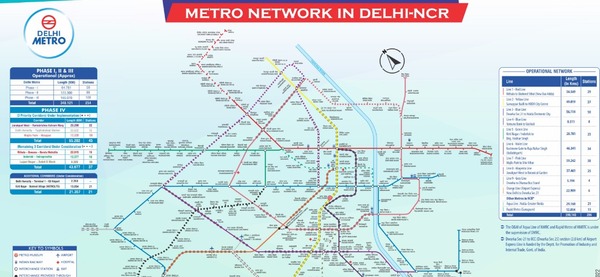Notifications
ALL BUSINESS
COMIDA
DIRECTORIES
ENTERTAINMENT
FINER THINGS
HEALTH
MARKETPLACE
MEMBER's ONLY
MONEY MATTER$
MOTIVATIONAL
NEWS & WEATHER
TECHNOLOGIA
TV NETWORKS
VIDEOS
VOTE USA 2026/2028
INVESTOR RELATIONS
DEV FOR 2025 / 2026
ALL BUSINESS
COMIDA
DIRECTORIES
ENTERTAINMENT
FINER THINGS
HEALTH
MARKETPLACE
MEMBER's ONLY
MONEY MATTER$
MOTIVATIONAL
NEWS & WEATHER
TECHNOLOGIA
TV NETWORKS
VIDEOS
VOTE USA 2026/2028
INVESTOR RELATIONS
DEV FOR 2025 / 2026
 Housiey Housiey -
17 hours ago -
Other -
Delhi Metro Blue line
Delhi News
Metro delhi
-
26 views -
0 Comments -
0 Likes -
0 Reviews
Housiey Housiey -
17 hours ago -
Other -
Delhi Metro Blue line
Delhi News
Metro delhi
-
26 views -
0 Comments -
0 Likes -
0 Reviews

Explore more to understand how the Delhi Metro Blue Line 2025 transforms commuting across the national capital. The route spans vital zones, helps residents save time, and supports Delhi’s urban development strategy. Daily travelers benefit from faster connections and a reliable network.
The Delhi Metro Blue Line serves as a backbone of Delhi’s metro infrastructure. Connecting the eastern and western ends of the city, the Blue Line simplifies long-distance travel. Commuters who depend on efficiency and speed rely heavily on this corridor.
Delhi Metro introduced the Blue Line in earlier phases, and now the 2025 plan expands this route even further. Enhanced connectivity, route extension, and improved station access mark this development phase. Delhi Metro Rail Corporation (DMRC) focuses on making the Blue Line the most comprehensive link between urban and suburban regions.
The Blue Line operates in two branches: Dwarka Sector 21 to Noida City Centre and Yamuna Bank to Vaishali. These routes converge at the Yamuna Bank junction. In the 2025 upgrade, authorities have streamlined the interchange flow and added new stations in densely populated sectors.
New stations provide direct connections to residential, industrial, and commercial zones. This strategic route development reflects careful urban planning. The expanded track reduces congestion on parallel lines and improves passenger distribution.
The Blue Line intersects with other key lines at major metro junctions. These interchange stations improve inter-line transfers without delays.
Rajiv Chowk connects the Blue and Yellow Lines.
Mandi House allows seamless travel between Blue and Violet Lines.
Yamuna Bank works as a junction for two Blue Line branches.
Dwarka Sector 21 links with the Airport Express Line.
These stations serve as high-traffic hubs. In 2025, DMRC enhances interchange design to make passenger movement smooth and time-efficient.
The National Capital Region (NCR) includes major residential areas in Noida, Ghaziabad, and Dwarka. The Blue Line reaches deep into these zones, connecting them with Delhi’s central business districts. This direct access saves travel time, reduces fuel dependency, and supports eco-friendly mobility.
Students, working professionals, and tourists gain equal advantage from this line. The 2025 expansion increases the number of direct routes to important institutions, tech parks, and historical landmarks.
Delhi Metro ensures frequent services during peak and off-peak hours. Trains arrive every few minutes, minimizing wait times. Timetables match public demand, especially during office hours and weekends.
In 2025, the Blue Line runs with upgraded train frequency. Additional rakes and improved scheduling handle increased passenger load. Early morning and late-night travelers also benefit from extended operational hours.
The DMRC mobile app and station displays show live updates, helping riders plan better. Onboard announcements and multi-lingual digital signage guide commuters effectively.
Metro route maps guide passengers through station stops and interchange points. Updated Blue Line maps include new stations and revised route diagrams.
Printed maps appear inside trains, at station entry points, and across platforms. DMRC also integrates real-time maps into its mobile apps. Google Maps and other digital services reflect these changes as well.
Each new station features navigation signs in Hindi and English. This bilingual system simplifies travel for local and international commuters alike.
DMRC prioritizes inclusive transportation. The Blue Line 2025 design includes enhanced accessibility at every station.
Elevators, tactile paths, and ramps assist senior citizens and differently-abled passengers. Platform screen doors and automated gates improve passenger safety. Uniform lighting, surveillance cameras, and helpdesks provide extra assurance.
Commuters with strollers or luggage navigate stations easily. Ticket counters and customer care centers now offer accessibility support.
Safety remains a top priority. In 2025, DMRC has upgraded surveillance systems, platform safety tools, and emergency response measures.
Each station includes CCTV surveillance and trained security staff. Baggage scanners and frisking points maintain security without causing delays. Train interiors also have panic buttons and intercom systems to handle emergencies.
Fire extinguishers, smoke detectors, and fire exits follow national safety protocols. Staff members undergo regular drills to stay prepared.
DMRC promotes cashless travel through smart cards and digital wallets. The 2025 rollout supports QR code scanning, UPI transactions, and online ticket booking.
Recharge points are available at stations and online portals. Contactless entry speeds up the boarding process. Smart card discounts also encourage regular travel via metro.
Integration with national ticketing systems and transport apps offers multi-modal convenience. This feature benefits those who use buses, autos, and metro in a single commute.
Delhi Metro leads green transit innovations in India. The Blue Line includes multiple sustainability initiatives.
Solar panels on station rooftops power lighting systems. Rainwater harvesting units support station water needs. Energy-efficient lighting and ventilation reduce electricity consumption.
Trains follow regenerative braking methods, saving power during halts. Clean surroundings, waste segregation units, and regular audits uphold environmental benchmarks.
Daily commuters experience reduced stress, shorter travel times, and reliable transport through this route. Smooth rides, clean coaches, and punctual schedules define the Blue Line experience.
Those who work far from home rely on this metro corridor for timely arrivals. Noida, Dwarka, and central Delhi office zones stay connected through uninterrupted service.
Weekend travelers use this route for quick access to malls, parks, and tourist spots. Students heading to Delhi University or other colleges benefit equally.
DMRC constantly improves commuter experience by enhancing station infrastructure. Washrooms, food kiosks, seating areas, and first aid points exist across stations.
New stations in 2025 include digital kiosks for ticketing and information. Helpdesks, signage, and trained staff support newcomers and tourists.
Wi-Fi, charging ports, and lounge areas create a more modern, comfortable experience. Women-only coaches and help booths maintain commuter safety standards.
Though the 2025 plan focuses on strengthening the current Blue Line, long-term visions aim for further expansion. Possible extensions into new residential zones and city outskirts appear in DMRC’s strategic plans.
Feasibility studies for additional interchange options and cross-border metro links with nearby states continue. These plans ensure scalability and support Delhi’s future population growth.
DMRC also considers partnerships with private developers and local bodies for station-based commercial development. This strategy helps improve infrastructure while generating revenue.
Travelers use the Blue Line to reach iconic destinations across Delhi and NCR.
Akshardham Temple sits adjacent to Akshardham station.
Rajiv Chowk connects visitors to Connaught Place, a shopping and dining hub.
Laxmi Nagar and Noida Sector 18 offer malls, street food, and nightlife.
By linking these attractions, the Blue Line serves both daily commuters and tourists. The stations near heritage sites also display cultural decor and historical information panels.
Property near metro stations usually gains better market value. The Blue Line supports this trend by making areas like Dwarka, Noida, and Vaishali more attractive.
Developers invest in commercial complexes near metro stations. Residents prefer homes within walking distance from stations. The metro improves quality of life by cutting commute times and offering easy access to daily needs.
In 2025, areas along the Blue Line continue to see infrastructure upgrades, increased footfall, and better public facilities.
DMRC uses multiple platforms to communicate updates. Follow the official DMRC website and social media channels for the latest news.
Use the DMRC mobile app to check train timings, live maps, and station updates. Announcements at stations and newspapers also provide service alerts and changes.
Subscribe to email alerts or SMS notifications through official channels for real-time updates. This ensures that passengers never miss a change in route or schedule.
The Delhi Metro Blue Line 2025 shows how infrastructure, planning, and technology can transform urban travel. It reduces traffic, saves time, and improves the daily lives of millions.
Metro lines like the Blue Line serve as a symbol of progress. The future of Delhi depends on such smart transit solutions, and the Blue Line leads the way.
Contact us to learn how infrastructure improvements like the Delhi Metro Blue Line 2025 contribute to smarter cities and better living. We’re here to provide updates, insights, and resources for urban development and transportation
The Delhi Metro Blue Line 2025 refers to the latest phase of the Blue Line expansion, connecting more stations, improving service frequency, and enhancing commuter experience across key areas in Delhi, Noida, and Ghaziabad.
The Blue Line connects Dwarka Sector 21 to Noida City Centre and Yamuna Bank to Vaishali, covering major residential, commercial, and industrial zones in Delhi NCR.
Key interchange stations include Rajiv Chowk, Mandi House, Yamuna Bank, and Dwarka Sector 21, offering seamless connections to other metro lines and Airport Express.
The Blue Line has two operational branches:
Dwarka Sector 21 to Noida City Centre
Yamuna Bank to Vaishali
Both branches merge at Yamuna Bank station.
The Blue Line operates from early morning until late night, with increased frequency during peak hours. DMRC updates exact timings regularly on its app and website.
Yes, DMRC has added several new stations in the 2025 plan to increase reach, improve accessibility, and support the growing population along the corridor.
Yes. DMRC has implemented CCTV surveillance, dedicated security personnel, and panic alarms across all Blue Line stations and trains to ensure commuter safety.
Yes. Passengers can use smart cards, UPI payments, and QR code scanning for contactless and convenient travel on the Delhi Metro Blue Line.
Yes. All stations include ramps, elevators, tactile tiles, and accessible restrooms to ensure a smooth experience for everyone.
You can stay updated via the DMRC mobile app, official DMRC website, and social media platforms for live information on train schedules, routes, and service alerts.
